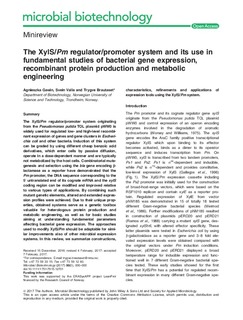| dc.contributor.author | Gawin, Agnieszka | |
| dc.contributor.author | Valla, Svein | |
| dc.contributor.author | Brautaset, Trygve | |
| dc.date.accessioned | 2017-10-18T07:42:59Z | |
| dc.date.available | 2017-10-18T07:42:59Z | |
| dc.date.created | 2017-03-16T13:18:50Z | |
| dc.date.issued | 2017 | |
| dc.identifier.citation | Microbial Biotechnology. 2017, . | nb_NO |
| dc.identifier.issn | 1751-7907 | |
| dc.identifier.uri | http://hdl.handle.net/11250/2460678 | |
| dc.description.abstract | The XylS/Pm regulator/promoter system originating from the Pseudomonas putida TOL plasmid pWW0 is widely used for regulated low- and high-level recombinant expression of genes and gene clusters in Escherichia coli and other bacteria. Induction of this system can be graded by using different cheap benzoic acid derivatives, which enter cells by passive diffusion, operate in a dose-dependent manner and are typically not metabolized by the host cells. Combinatorial mutagenesis and selection using the bla gene encoding blactamase as a reporter have demonstrated that the Pm promoter, the DNA sequence corresponding to the 50 untranslated end of its cognate mRNA and the xylS coding region can be modified and improved relative to various types of applications. By combining such mutant genetic elements, altered and extended expression profiles were achieved. Due to their unique properties, obtained systems serve as a genetic toolbox valuable for heterologous protein production and metabolic engineering, as well as for basic studies aiming at understanding fundamental parameters affecting bacterial gene expression. The approaches used to modify XylS/Pm should be adaptable for similar improvements also of other microbial expression systems. In this review, we summarize constructions, characteristics, refinements and applications of expression tools using the XylS/Pm system. | nb_NO |
| dc.language.iso | eng | nb_NO |
| dc.publisher | Wiley | nb_NO |
| dc.rights | Navngivelse 4.0 Internasjonal | * |
| dc.rights.uri | http://creativecommons.org/licenses/by/4.0/deed.no | * |
| dc.title | The XylS/Pm regulator/promoter system and its use in fundamental studies of bacterial gene expression, recombinant protein production and metabolic engineering. | nb_NO |
| dc.type | Journal article | nb_NO |
| dc.type | Peer reviewed | nb_NO |
| dc.description.version | publishedVersion | nb_NO |
| dc.source.pagenumber | 17 | nb_NO |
| dc.source.journal | Microbial Biotechnology | nb_NO |
| dc.identifier.doi | 10.1111/1751-7915.12701 | |
| dc.identifier.cristin | 1458763 | |
| dc.description.localcode | © 2017 The Authors. Published by John Wiley & Sons Ltd and Society for Applied Microbiology. This is an open access article under the terms of the Creative Commons Attribution License (CC BY 4.0) | nb_NO |
| cristin.unitcode | 194,66,15,0 | |
| cristin.unitname | Institutt for bioteknologi | |
| cristin.ispublished | true | |
| cristin.fulltext | original | |
| cristin.qualitycode | 1 | |

